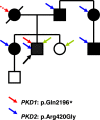Bilineal inheritance of pathogenic PKD1 and PKD2 variants in a Czech family with autosomal dominant polycystic kidney disease - a case report
- PMID: 29973168
- PMCID: PMC6032778
- DOI: 10.1186/s12882-018-0978-2
Bilineal inheritance of pathogenic PKD1 and PKD2 variants in a Czech family with autosomal dominant polycystic kidney disease - a case report
Abstract
Background: Autosomal dominant polycystic kidney disease (ADPKD) is the most common hereditary renal disorder, leading to end stage renal failure and kidney transplantation in its most serious form. The severity of the disease's manifestation depends on the genetic determination of ADPKD. The huge variability of different phenotypes (even within a single family) is not only modulated by the two main ADPKD genes (PKD1 and PKD2) but also by modifier genes and the whole genetic background.
Case presentation: This is a report of an ADPKD family with co-inheritance of PKD1 and PKD2 pathogenic variants. The proband, with an extremely serious manifestation of ADPKD (the man was diagnosed in early childhood, and with end stage renal disease aged 23), underwent genetic analysis of PKD1 and PKD2, which revealed the presence of pathogenic mutations in both of these genes. The missense PKD2 mutation p.Arg420Gly came from the proband's father, with a mild ADPKD phenotype. The same mutation of the PKD2 gene and similar mild disease presentation were found in the proband's aunt (father's sister) and her son. The nonsense mutation p.Gln2196* within the PKD1 gene was probably inherited from the proband's mother, who died at the age of 45. It was only discovered post mortem, that the real cause of her death was kidney failure as a consequence of untreated ADPKD. Unfortunately, neither the DNA of the proband's mother nor the DNA of any other family members from this side of the pedigree were available for further examination. The proband underwent successful cadaveric kidney transplantation at the age of 24, and this replacement therapy lasted for the next 15 years.
Conclusions: Here, we present a first case of bilineal ADPKD inheritance in the Czech Republic. This report highlights the significant role of modifier genes in genetic determination of ADPKD, especially in connection with seriously deteriorated disease phenotypes. In our case, the modifying role is probably mediated by the PKD2 gene.
Keywords: ADPKD; Bilineal inheritance; Causative mutation; Modifier gene; PKD1/2 gene.
Conflict of interest statement
Ethics approval and consent to participate
The study was approved by the Ethics Committee of General University Hospital in Prague. All examined patients provided written informed consent for genetic testing.
Consent for publication
Written informed consent for participation in the anonymous research as well as for publication of its results (together with any related accompanying images) was obtained from all participating family members.
Competing interests
The authors declare that they have no competing interests.
Publisher’s Note
Springer Nature remains neutral with regard to jurisdictional claims in published maps and institutional affiliations.
Figures

Similar articles
-
Co-inheritance of pathogenic variants in PKD1 and PKD2 genes presenting as severe antenatal phenotype of autosomal dominant polycystic kidney disease.Eur J Med Genet. 2020 Mar;63(3):103734. doi: 10.1016/j.ejmg.2019.103734. Epub 2019 Jul 23. Eur J Med Genet. 2020. PMID: 31349084
-
Autosomal dominant polycystic kidney disease in a family with mosaicism and hypomorphic allele.BMC Nephrol. 2013 Mar 15;14:59. doi: 10.1186/1471-2369-14-59. BMC Nephrol. 2013. PMID: 23496908 Free PMC article.
-
New mutations in the PKD1 gene in Czech population with autosomal dominant polycystic kidney disease.BMC Med Genet. 2009 Aug 17;10:78. doi: 10.1186/1471-2350-10-78. BMC Med Genet. 2009. PMID: 19686598 Free PMC article.
-
Modifiers of Autosomal Dominant Polycystic Kidney Disease Severity: The Role of PKD1 Hypomorphic Alleles.Genes (Basel). 2023 Jun 7;14(6):1230. doi: 10.3390/genes14061230. Genes (Basel). 2023. PMID: 37372410 Free PMC article. Review.
-
Genetics and pathogenesis of autosomal dominant polycystic kidney disease: 20 years on.Hum Mutat. 2014 Dec;35(12):1393-406. doi: 10.1002/humu.22708. Hum Mutat. 2014. PMID: 25263802 Review.
Cited by
-
Gene Panel Analysis in a Large Cohort of Patients With Autosomal Dominant Polycystic Kidney Disease Allows the Identification of 80 Potentially Causative Novel Variants and the Characterization of a Complex Genetic Architecture in a Subset of Families.Front Genet. 2020 May 7;11:464. doi: 10.3389/fgene.2020.00464. eCollection 2020. Front Genet. 2020. PMID: 32457805 Free PMC article.
-
Identification and Characterization of Novel Mutations in Chronic Kidney Disease (CKD) and Autosomal Dominant Polycystic Kidney Disease (ADPKD) in Saudi Subjects by Whole-Exome Sequencing.Medicina (Kaunas). 2022 Nov 16;58(11):1657. doi: 10.3390/medicina58111657. Medicina (Kaunas). 2022. PMID: 36422197 Free PMC article.
-
Polycystic Kidney Disease Caused by Bilineal Inheritance of Truncating PKD1 as Well as PKD2 Mutations.Kidney Int Rep. 2020 Jul 17;5(10):1828-1832. doi: 10.1016/j.ekir.2020.07.006. eCollection 2020 Oct. Kidney Int Rep. 2020. PMID: 33102977 Free PMC article. No abstract available.
-
Co-Inheritance of Pathogenic Variants in PKD1 and PKD2 Genes Determined by Parental Segregation and De Novo Origin: A Case Report.Genes (Basel). 2023 Aug 6;14(8):1589. doi: 10.3390/genes14081589. Genes (Basel). 2023. PMID: 37628640 Free PMC article.
-
Rare genetic causes of complex kidney and urological diseases.Nat Rev Nephrol. 2020 Nov;16(11):641-656. doi: 10.1038/s41581-020-0325-2. Epub 2020 Aug 17. Nat Rev Nephrol. 2020. PMID: 32807983 Free PMC article. Review.
References
-
- Chapman AB, Devuyst O, Eckardt KU, Gansevoort RT, Harris T, Horie S, et al. Autosomal dominant polycystic kidney disease (ADPKD): executive summary from a kidney disease: improving global outcomes (KDIGO) controversies conference. Kidney Int. 2015;88(1):17–27. doi: 10.1038/ki.2015.59. - DOI - PMC - PubMed
Publication types
MeSH terms
Substances
LinkOut - more resources
Full Text Sources
Other Literature Sources
Miscellaneous

